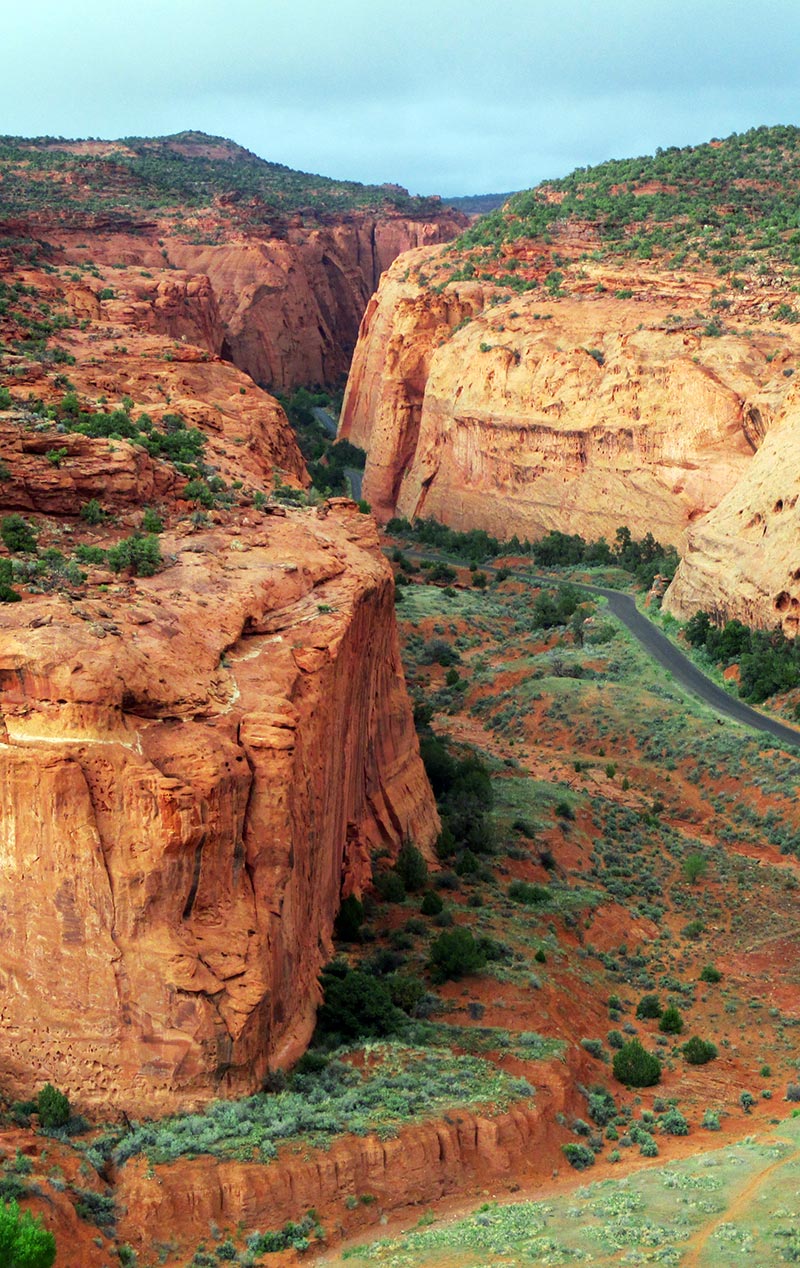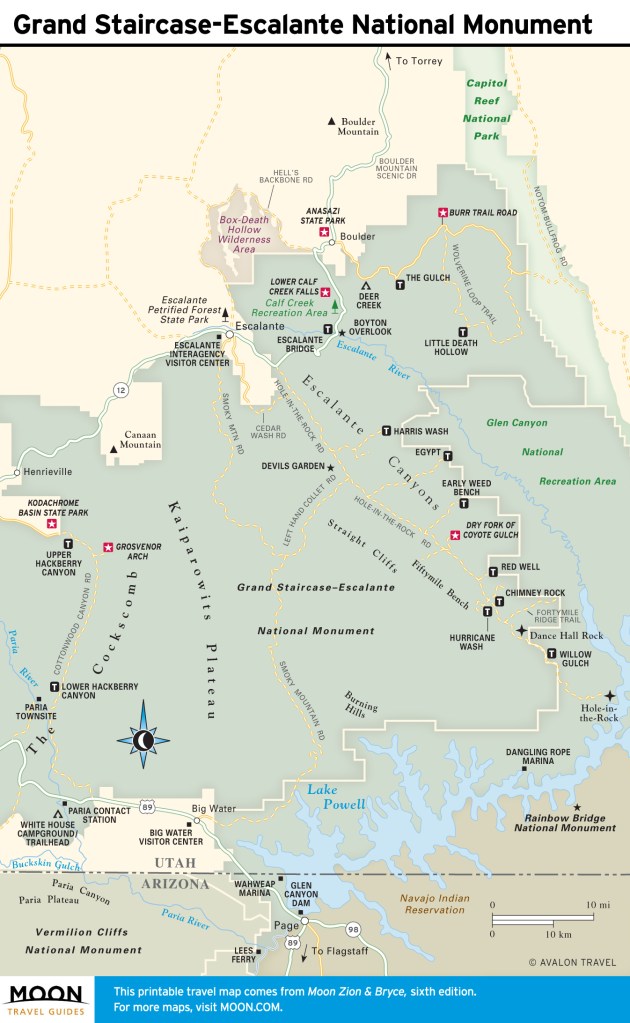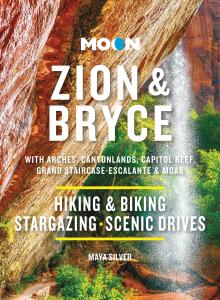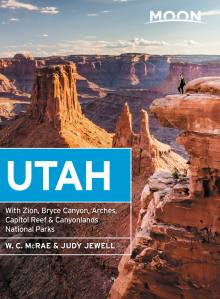Visit Grand Staircase-Escalante National Monument
The 1.9-million-acre Grand Staircase-Escalante National Monument (GSENM) contains a vast and wonderfully scenic collection of slickrock canyon lands and desert, prehistoric village sites, Old West ranch land, arid plateaus, and miles of back roads linking stone arches, mesas, and abstract rock formations. The monument even preserves a historic movie set (think vintage Westerns).
The monument contains essentially three separate districts: On the eastern third are the narrow wilderness canyons of the Escalante River and its tributaries. In the center of the monument is a vast swath of arid rangeland and canyons called the Kaiparowits Plateau, with few developed destinations. The western third of the monument edges up against the Gray, White, and Pink Cliffs of the Grand Staircase. These thinly treed uplands are laced with former Forest Service roads. The GSENM is the largest land grouping designated as a national monument in the Lower 48.

There’s little dispute that the Escalante canyons are the primary reason people visit the monument. The river and its tributaries cut deep and winding slot canyons through massive slickrock formations, and hiking these canyon bottoms is an extremely popular adventure. A multiday trek is a rite of passage for many devoted hikers, but you don’t have to be a hardened backcountry trekker to enjoy this landscape: Two backcountry roads wind through the area, and some day hikes are possible.
The other districts offer less-well-defined opportunities for adventure. Backcountry drivers and long-distance mountain bikers will find mile after mile of desert and canyon to explore. Grosvenor Arch, with double windows, is a popular back-road destination. At the southern edge of the park, along the Arizona border, is another rugged canyon system that’s popular with long-distance hikers. The Paria River Canyon is even more remote than the Escalante, and hiking these slot canyons requires experience and preparation.
Newsletter Signup
By clicking ‘Sign Up,’ I acknowledge that I have read and agree to Hachette Book Group’s Privacy Policy and Terms of Use
Planning Your Time
If you only have one day, plan to drive stunning Highway 12. The Lower Calf Creek Falls hike begins right off the highway between Escalante and Boulder, and hiking it is a great way to spend half a day.
If you have an additional day or two, it makes sense to base yourself either in Escalante (convenient camping and moderately priced accommodations) or in Boulder (where it’s possible to sleep and eat in luxury). Spend your second day here exploring Hole-in-the-Rock Road, where you can hike slot canyons in the Dry Fork of Coyote Gulch and explore Devils Garden. It’s possible to stay in this area of the monument for several days, either backpacking along the Escalante River or exploring its various canyons as day hikes. If you’re at all up to backpacking, it’s only a one-nighter to hike from the town of Escalante along the river to the river’s highway crossing.
If you have more time, drive between the Kanab area and Cannonville on Cottonwood Canyon Road (be sure to check on road conditions before heading out). Stop and walk up through the Cottonwood Narrows, and at the north end of the road, visit Grosvenor Arch and Kodachrome State Park. If you want to make a loop drive, return on the Johnson Canyon and Skutumpah Roads, with a hike along Lick Wash.
Exploring the Park
There is no entrance fee to visit Grand Staircase-Escalante National Monument (435/644-1200). Free permits are required for all overnight backcountry camping or backpacking. There is a fee to camp in the monument’s three developed campgrounds.
Hikers in the Paria Wilderness area, which includes Paria Canyon and Coyote Buttes, are required to buy a permit, as are hikers at the Calf Creek Recreation Area.
It’s best to have a travel strategy when visiting this huge national monument. Just as important, especially for a visit of more than a couple of days, is a vehicle that can take on some rugged roads. (A Subaru wagon proved perfectly adequate in dry weather, but when the clay was wet and muddy, the back roads were virtually impassable in all but 4WD vehicles with significantly higher clearance than a station wagon.)

Only two paved roads pass through the monument, both on a west-east trajectory. Highway 12, on the northern boundary of the park, links Bryce Canyon and Capitol Reef National Parks with access to the Escalante canyons. This is one of the most scenic roads in Utah—in fact, Car and Driver magazine rates this route as one of the 10 most scenic in the United States. Its innumerable vistas and geologic curiosities will keep you on the edge of your seat. U.S. 89, which runs along the southern edge of the monument between Kanab and Lake Powell, is no scenery slouch either. It is also the access road for the North Rim of the Grand Canyon in Arizona.
Three fair-weather dirt roads, each with a network of side roads and trails, cut through the rugged heart of the monument, linking the two paved roads. Before heading out on these back roads, check with the visitors center for conditions; high-clearance vehicles are recommended.
Newsletter Signup
By clicking ‘Sign Up,’ I acknowledge that I have read and agree to Hachette Book Group’s Privacy Policy and Terms of Use
Pin for Later




